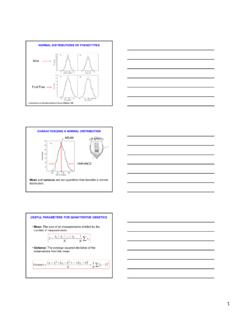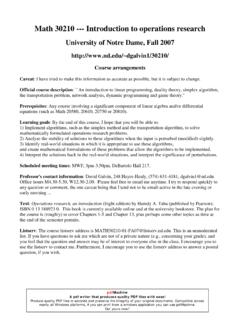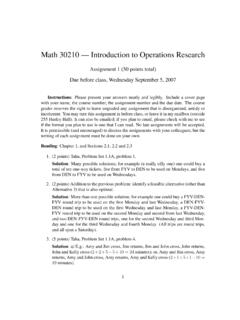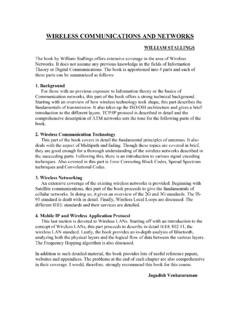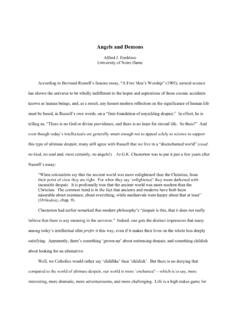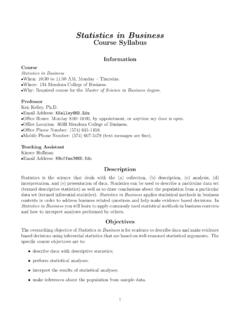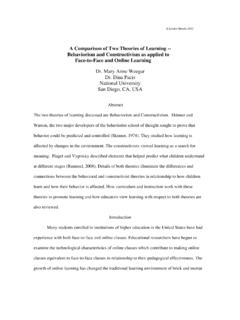Transcription of Fast Fashion, Sustainability, and the Ethical Appeal F ...
1 fashion Theory, Volume 16, Issue 3, pp. 273 296 DOI: available directly from the permitted by licence only. 2012 fashion , Sustainability, and the Ethical Appeal of Luxury BrandsAnnamma Joy, John F. Sherry, Jr, Alladi Venkatesh, Jeff Wang and Ricky ChanAnnamma Joy, University of British Columbia, F. Sherry, Jr, University of Notre Dame, Venkatesh, University of California, Irvine, Wang, City University of Hong Chan, Hong Kong Polytechnic phrase fast fashion refers to low-cost clothing collections that mimic current luxury fashion trends. Fast fashion helps sate deeply held desires among young consumers in the industrialized world for luxury fashion , even as it embodies unsustainability. Trends run their course with lightning speed, with today s latest styles swiftly trumping yesterday s, which have already been consigned to the trash bin.
2 This article addresses the inherent dissonance among fast fashion consum-ers, who often share a concern for environmental issues even as they indulge in consumer patterns antithetical to ecological best practices. 274 Annamma Joy, John F. Sherry, Jr, Alladi Venkatesh, Jeff Wang and Ricky Chan Seemingly adept at compartmentalism, and free of conflicted guilt, such consumers see no contradiction in their Janus-faced desires. Can luxury fashion , with ostensibly an emphasis on authenticity, and its concom-itant respect for artisans and the environment, foster values of both quality and sustainability? Since individual identity continually evolves, and requires a materially referential re-imagining of self to do so, we hypothesize that actual rather than faux luxury brands can, ironically, unite the ideals of fashion with those of environmental : luxury brands, fast fashion , sustainability, quality and consumer behaviorIntroductionOver the past decade, sustainability and Ethical conduct have begun to matter in fashion (Emberley 1998; Moisander and Personen 2002); companies have realized that affordable and trend-sensitive fashion , while typically highly profitable, also raises Ethical issues (Aspers and Skov 2006).
3 How do today s young consumers, so conscious of green values, balance their continual need for ever-newer fashion with their presumed commitment to environmental sustainability? In our research, we ask how such consumers perceive fast fashion versus its luxury coun-terpart, what sustainability actually means to them, and, based on our findings, how the fashion industry can address : The Social ContractSustainability of necessity a primary issue of the twenty-first century is often paired with corporate social responsibility (Aguilera et al. 2007), informed purchasing decisions, and an emerging green orienta-tion at some companies (Bansal and Roth 2000). Sustainability has many definitions, with the three most common being an activity that can be continued indefinitely without causing harm; doing unto others as you would have them do unto you; and meeting a current generation s needs without compromising those of future generations (Fletcher 2008; Partridge 2011; Report of the World Commission on Environment and Development 1987).
4 Seidman (2007: 58) notes, Sustainability is about much more than our relationship with the environment; it s about our relationship with ourselves, our communities, and our institutions. Sustainability involves complex and changing environmental dy-namics that affect human livelihoods and well-being, with intersect-ing ecological, economic, and sociopolitical dimensions, both globally and locally. Langenwater (2009: 11) lists some essential principles of a Fast fashion , Sustainability, and the Ethical Appeal of Luxury Brands 275sustainable policy for companies: Respect for people (at all levels of the organization), the community, and its supply chain; respect for the planet, recognizing that resources are finite; and generating profits that arise from adhering to these principles. Organizations are embedded in society, and reflect the value they offer society, which raises profound issues.
5 As Beard (2008: 448) states, The difficulty (in the fashion in-dustry) is to see how all the suppliers of the individual components can be ethically secured and accounted for, together with the labour used to manufacture the garment, its transport from factory to retail outlet, and ultimately the garment s aftercare and disposal. With a global reach, the fashion industry supply chain is highly fragmented and inherently complex; as a result, fashion manufacturing is even less transparent than agribusiness (Mihm 2010; Partridge 2011).Why Is Fast fashion Unsustainable?Fast fashion low-cost clothing collections based on current, high-cost luxury fashion trends is, by its very nature, a fast-response system that encourages disposability (Fletcher 2008). A formerly standard turnaround time from catwalk to consumer of six months is now com-pressed to a matter of mere weeks by such companies as H&M and Zara, with heightened profits to match (Tokatli 2008).
6 Fast fashion companies thrive on fast cycles: rapid prototyping, small batches com-bined with large variety, more efficient transportation and delivery, and merchandise that is presented floor ready on hangers with price tags already attached (Skov 2002).To keep customers coming back, high street retailers routinely source new trends in the field, and purchase on a weekly basis to intro-duce new items and replenish stock (Tokatli and Kizilgun 2009). The side effect of such continual and rapid turnover: a new form of seem-ingly contradictory mass exclusivity (Schrank 2004). Moreover, lower manufacturing and labor costs mean lower costs overall, which result in lower prices, which, in turn, equal higher volume. Even companies such as Zara, which once manufactured all their goods in Europe, re-sulting in better quality control, now outsource at least 13 percent of their manufacturing to China and Turkey.
7 Shipping time from China to Europe may take three weeks, but it only takes five days from Tur-key (Tokatli 2008). Admittedly, fast fashion companies do employ sta-bles of in-house designers: more eye-catching designs lead to trendier, must-have fashions, which lure consumers into paying full price now rather than deferring gratification until the year-end sales arrive. When faced with tight delivery demands, fast fashion companies will even use higher-cost local labor and expedited shipping methods. In due time , future financial returns will far outweigh current costs (Cachon and Swinney 2011).276 Annamma Joy, John F. Sherry, Jr, Alladi Venkatesh, Jeff Wang and Ricky Chan Avid consumers are now primed to browse fast fashion stores every three weeks or so in search of new styles (Barnes and Lea-Greenwood 2006). According to a former Topshop brand director, Girls see some-thing and want it immediately.
8 The fast fashion industry in com-mon with the technology industry, which similarly produces a constant stream of ever-improved, ever more alluring, products exists courtesy of such impulsive behavior, employing the planned obsolescence prac-tices recently identified by Guiltinan (2009: 20): limited functional life design and options for repair, design aesthetics that eventually lead to reduced satisfaction, design for transient fashion , and design for func-tional enhancement that requires adding new product features. fashion , more than any other industry in the world, embraces obsolescence as a primary goal; fast fashion simply raises the stakes (Abrahamson 2011).Young consumers desire for fast fashion is coupled with significant disposable income (or, alternatively, the availability of credit). Fast fashion exploits this segment, offering of-the-moment design and the immediate gratification of continually evolving temporary identities a postmodern phenomenon (Bauman 2005).
9 Fast fashion has been re-ferred to as McFashion, because of the speed with which gratification is provided. The framework is global, and the term McFashion is, to a degree, appropriate. According to Ritzer (2011: 1), McDonaldiza-tion is a term that became fashionable in discussing changes in capital-ist economies as they moved toward greater rationalization. Types of production matter: manufacturing reliant on artisanal craft is a distinct system, as are those of mass and more limited production. Craft denotes highly skilled labor, using simple tools to make unique items, one item at a time , and accessible to only a select clientele. Hermes af-fluent customers, for example, might wait for several years to acquire a particular bag (Tungate 2009). With fast fashion , new styles swiftly supersede the old, defining and sustaining constantly emerging desires and notions of self.
10 As Binkley (2008: 602) argues, the idea of multiple selves in evolution is central to fast fashion lovers. Fast fashion re-places exclusivity, glamour, originality, and luxury with massclusivity and planned spontaneity (Toktali 2008).Unsurprisingly, fast fashion chains in Europe have grown faster than the retail fashion industry as a whole (Cachon and Swinney 2011; Mihm 2010): low cost, fresh design, and quick response times allow for greater efficiency in meeting consumer demand. Fast fash-ion chains typically earn higher profit margins on average, a sizeable 16 percent than their traditional fashion retail counterparts, who average only 7 percent (Sull and Turconi 2008). Their success is in-disputably significant. Consider the case of Zara, an exemplar of fast fashion : the brand s publicly held parent company, Inditex, operates 2,700 stores in more than sixty countries, and is valued at US$24 bil-lion, with annual sales of $8 billion (Crofton and Dopico 2006: 41).
